| home this issue archives editorial board contact us faculty website |

| Vol.
XVI No.
5 April / May 2004 |
| contents |
| Printable Version |
Research at MIT
The MIT/WHOI Joint Program in Oceanography and Applied Ocean Science and Engineering
How many people at the Institute know that MIT, together with the Woods Hole Oceanographic Institution, has what has been defined as " the top graduate program – or arguably one of the two top programs – in marine science in the world"? [MIT/WHOI External Review Committee, 1998.]
The program was created in May 1968 with a Memorandum of Agreement (MOA) between the MIT Corporation and the WHOI Board of Trustees, signed by MIT President Howard J. Johnson and WHOI President Paul M. Fye, thereby establishing that the appropriate graduate degrees in oceanography would be conferred jointly by the two Institutions.
The original motivations for the creation of the program, outlined in the MOA, still stand on strong ground and can be projected into the future even more strongly. The recognition made 36 years ago that "Oceanography is becoming an increasingly important component of the earth sciences" could be rephrased today by emphasizing the crucial role that the oceans play in the science of climate and global change, and the fact that, in spite of the enormous progress achieved in the last 25 years, the world ocean is still the least known and least explored component of the entire Earth's system.
Furthermore, because of the new compelling urgency for understanding and predicting climate change, oceanographic sciences are presently in a "renaissance" period, in which both observational and theoretical components are progressing at a rapid pace in all the sub-disciplines.
And now to the contents of our science: What is Oceanography?
The name is a large "umbrella" for the ensemble of basic sciences and engineering investigated in the context of the oceanic environment. Thus "Physical Oceanography" is "Physics of the Ocean" as well as "Fluid Mechanics" (when the fluid is sea water). [I am a Physical Oceanographer.] Analogous definitions could be given for the other sub-disciplines even though, with the ever increasing importance of interdisciplinary research, the boundaries among the sub-disciplines are becoming more and more blurred. Perhaps the most important example of which is the effort to understand climate and its variability requires not only a close interaction among chemical, physical, and biological oceanographers, but also a close interaction with the atmospheric community.
| Back to top |
I will try to illustrate briefly the major scientific issues at the core of each sub-discipline.
Chemical Oceanography is the study of the pathways that chemical species follow on their transit through the oceans. Chemical oceanographers examine vast ranges of time and space scales, from the molecular level to the global in space, from fractions of a second to billions of years in time. Among the focal research areas is the development of new chemical sensors and new technologies to measure the composition of sea water throughout the ocean depth and in marine sediments, as well as to understand the controls on photosynthetic activity of organisms living in the surface ocean.
In an effort to understand past, abrupt climate changes, organic geochemists exploit knowledge of specific biochemical pathways to develop chemical and isotopic tracers of biogeochemical processes and sea water characteristics that have changed over time.
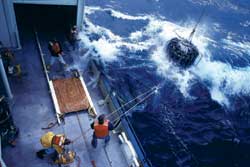
Such measurements are carried out from oceanographic research vessels, and Figure 1 shows the launching of a "rosette" from the oceanographic vessel Oceanus . The rosette is an ensemble of containers which are filled by sea water at different depths to measure its chemical and physical composition over large and different regions of the world ocean.
Physical Oceanography is the exploration and study of the physics and dynamics of ocean currents and water properties. Complex oceanic motions occur over a wide variety of space and time scales, from the boundary layer at the air-sea interface, to the grand persistent currents, like the Gulf Stream, and the wind-driven ocean gyres. These large-scale circulation systems transport a substantial fraction of heat from the equatorial zone to the poles, sequester carbon, transport freshwater as part of the global hydrological cycle, and may also precipitate rapid changes in climate. Crucially important in climate research is the study of the complex ocean-atmosphere land-ice interactions, including the reconstruction of the ocean paleoclimate as a key to understanding future abrupt climatic changes. These studies are carried out not only through the collection and analysis of observational data sets but, very importantly, using numerical models of the ocean general circulation (OGCMs). These provide a realistic description of the three-dimensional velocity field, of the temperature and salinity distributions in the world ocean and of their evolution in time.
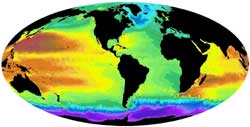
Figure 2 shows an example of an OGCM simulation of the water temperature at the sea surface at a specific day (a "snapshot"). The system of global currents is reflected in the pattern of the surface temperature.
Biological Oceanography is the study of life in the oceans - the distribution, abundance, and production of marine species along with the processes that govern these features. Biological oceanography is also a study of extremes: in size, from the tiny microbes in the water column to the 30-meter blue whale; in depth, from blooms of cyanobacteria covering thousands of square kilometers of the ocean's surface, to hydrothermal vent colonies emerging eerily from the dark, mile-deep ocean; in locale, from the lab next door to the deck of an oceanographic vessel bucking ice flows in the Arctic.
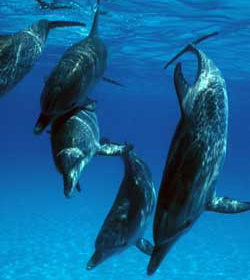
Among the focal areas of research are the study of the populations of organisms living on the ocean floor (benthic populations); of the distribution and physiological properties of some of the smallest organisms living in the ocean, such as microorganisms, phytoplankton, zooplankton; and the study of large marine mammals, of their auditory systems, social behavior, ways of communication and, in general, of their population dynamics. Figure 3 shows a group of dolphins spotted by WHOI scientists during an oceanographic expedition aimed at investigating the physiology and social patterns of these graceful, highly intelligent animals.
Marine Geology and Geophysics focuses on understanding how our planet works by investigating: the structure of the earth beneath the oceans; the processes that shape the sea floor; the history of ocean circulation patterns and climate change preserved in sea floor sediments; and the interactions between geological and biological systems. Marine geologists approach these problems through studies of oceanic rocks and sediments. Marine geophysicists are primarily concerned with the application of gravity, magnetics, heat flow, and seismic methods to study the structure of the earth beneath the oceans.
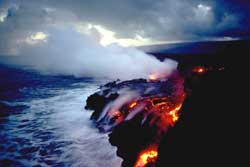
Focal research areas include understanding how coastal sedimentary systems function for the effective management of costal resources; sediment biogeochemistry, submarine hydrothermal systems and the origin of mineral deposits on the sea floor; melt generation and flow in the earth's mantle; and tectonics, including sea floor volcanic processes, ocean crustal structure, upper mantle dynamics, and ocean-continent interactions.
Fig. 4 shows a flow of lava from the land into the sea: geophysicists study volcanic eruptions on land to better understand those beneath the ocean.
Applied Ocean Science & Engineering is a discipline that combines basic research on a wide range of oceanic processes with applied research and engineering design of systems for the exploration, measurement, mapping, prediction, and beneficial use of the oceans.
Focal areas in the Joint Program include: Observing systems and sensors, which include the development of sea floor observatories, of moored observation systems, sensors and instruments, of optical and acoustical imaging systems; Vehicles and submarines, which includes underwater autonomous and remotely operated vehicles, towed vehicles, navigation and control; Ocean acoustics, that addresses the propagation of underwater sound, both as a scientific problem and as a tool for observing and operating in the ocean, including navigation, sea floor mapping, inference of the physical properties of the water column, underwater communication and signal processing; Environmental fluid mechanics, including surf-zone dynamics, dynamics of estuaries and embayments, turbulence, surface-wave dynamics, sediment transport.
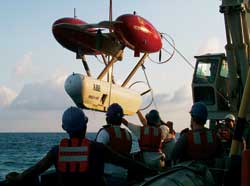
Fig. 5 shows the lowering from an oceanographic vessel of an Autonomous Benthic Explorer (ABE) for the study of benthic populations.
And now a short description of the Joint Program structure. It comprises four departments at MIT: Earth, Atmospheric and Planetary Sciences (EAPS) and Biology in the School of Science; and Civil and Environmental Engineering and Ocean Engineering in the School of Engineering, with occasional participation of Electrical Engineering and Computer Sciences and Mechanical Engineering. The Program has an MIT director who reports to the chancellor, the associate provost, and the provost. In correspondence, WHOI has five departments, one for each of the above sub-disciplines. The Program is directed by the WHOI Vice-President for Academic Programs and Dean, Dr. John Farrington, who reports to the WHOI Director and President, Dr. Robert Gagosian. As of the February 2004 degree list, 480 Doctoral degrees, 56 Masters of Engineering degrees, and 139 Masters of Science degrees have been awarded by the Program. The alumni/ae are among the leaders in ocean sciences and engineering worldwide in academic, industry, non-profit, and government research and education centers.
The above summaries of research activities in each oceanographic discipline are necessarily synthetic. I hope nonetheless to have conveyed the depth and breadth of marine science and the intellectual excitement of being an "oceanographer" today: sophisticated instrumentation mounted on satellites is providing unprecedented data sets of the ocean sea surface properties with synoptic and global coverage; the complexity of ocean interactions, and interactions with the atmosphere, land, and ice, are investigated by extremely sophisticated numerical models of all the components of the Earth's system, often in coupled mode; and at the same time conceptual models are developed to elucidate the basic physical and biogeochemical ocean processes.
If any MIT member wishes to be exposed to this excitement, come see me in the summer at Woods Hole. The Joint Program offers to the MIT faculty involved in it (as well as to students and postdocs) the possibility of spending the summer, or part of it, at WHOI, where we strengthen our interactions with our WHOI colleagues, both in research and education, and work closely with our students in the wonderful setting of Cape Cod: I can assure you that it is a great experience!
For a more detailed description of the research activities in the Joint Program see http://web.mit.edu/mit-whoi/www.
| Back to top | |
| Send your comments |
| home this issue archives editorial board contact us faculty website |